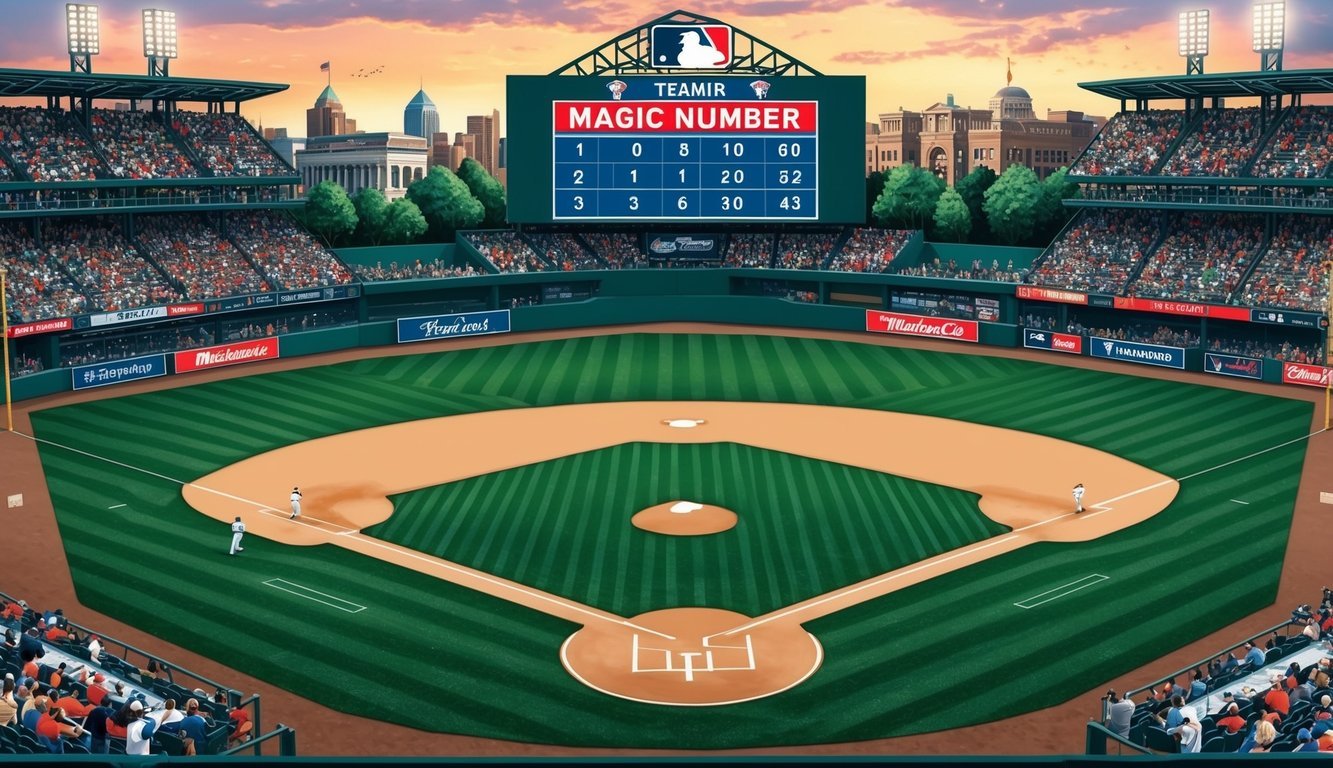As baseball season heats up, fans eagerly track their team’s progress toward the playoffs.
One key metric they watch is the magic number.
This crucial figure represents the combination of wins needed by a team and losses by its closest competitor to clinch a playoff spot or division title.
The magic number becomes especially significant in September when postseason races tighten.
Fans calculate it daily, watching it tick down as their team inches closer to securing a coveted playoff berth.
The lower the magic number drops, the more excitement builds among the fanbase.
Understanding the magic number allows fans to gauge their team’s playoff chances at a glance.
It adds an extra layer of drama to the final weeks of the season as teams battle to reduce their magic number to zero and punch their ticket to October baseball.
Understanding the Magic Number in Baseball
The magic number is a crucial concept in baseball that helps fans and teams track progress toward securing a playoff spot.
It provides a simple way to gauge how close a team is to clinching their division or a wild card berth.
Definition and Significance
The magic number represents the combination of wins by a leading team and losses by their closest competitor needed to guarantee a playoff position.
As the season progresses, this number decreases with each win by the leading team or loss by their rival.
When it reaches zero, the team has clinched.
For MLB teams, the magic number becomes especially important in September as the regular season winds down.
It creates excitement and anticipation among fans, who eagerly watch the standings and calculate their team’s chances of making the postseason.
Calculating the Magic Number
The basic formula for calculating a team’s magic number is:
Games in season + 1 – (Team’s wins) – (Second-place team’s losses)
For MLB’s 162-game season, it looks like this:
163 – (Team’s wins) – (Second-place team’s losses)
Let’s say the division leader has 89 wins and the second-place team has 63 losses.
The magic number would be:
163 – 89 – 63 = 11
This means any combination of 11 wins by the leader or losses by the second-place team will clinch the division title.
As the season progresses, teams and fans can easily track how close they are to securing a playoff spot.
The Role of the Magic Number in Playoff Races
The magic number plays a crucial role in determining playoff contention and energizing fans as the regular season winds down.
It creates tension and excitement in the final weeks of the baseball calendar.
Divisional Competitors and Wild Card Contenders
Teams vying for division titles closely monitor their magic numbers.
As the number shrinks, the pressure intensifies for both leaders and challengers.
A low magic number can spur a team to make a final push, while putting stress on trailing competitors.
Wild card races add another layer of complexity.
Teams must track multiple magic numbers – for both division and wild card berths.
This creates a dynamic landscape where standings can shift daily.
In tight races, teams may find themselves juggling priorities between clinching a wild card spot or chasing a division crown.
The magic number helps inform these strategic decisions in September.
Fan Engagement and Excitement
Magic numbers captivate baseball fans during pennant races.
They provide a tangible measure of a team’s playoff chances, fueling discussions and debates.
As magic numbers decrease, fan attendance often surges.
The possibility of witnessing a playoff-clinching game draws crowds to ballparks.
Social media buzzes with updates and projections.
For fans of contending teams, checking the daily magic number becomes a ritual.
It adds drama to each game, making seemingly routine matchups feel crucial.
Even casual followers get swept up in the excitement of a dwindling magic number.
The concept also helps fans understand complex playoff scenarios.
It simplifies the path to October baseball, making it easier to follow multiple races simultaneously.
Historical Context and Notable Magic Number Moments

The magic number concept has played a crucial role in baseball’s history, creating excitement and tension during pennant races.
Its origins and memorable moments have become part of the sport’s rich tapestry.
Origin of the Term and Historical Usage
The term “magic number” first appeared in a 1947 Washington Post article about the American League pennant race between the Boston Red Sox and New York Yankees.
It quickly caught on as a handy way to track a team’s progress toward clinching first place.
Baseball fans embraced the concept, using it to gauge their team’s chances of securing a pennant or playoff spot.
The magic number became a daily topic of conversation, appearing in newspapers and later on sports broadcasts.
As the years went by, Major League Baseball officially adopted the term.
Teams began displaying their magic numbers on scoreboards, adding to the drama of late-season games.
Memorable Clinches and Pennant Wins
The 1947 AL pennant race, which introduced the magic number concept, ended in dramatic fashion.
The Yankees clinched the flag in the season’s final days, edging out the Red Sox in a tight finish.
In 1951, the New York Giants staged an incredible comeback.
They erased a 13. 5-game deficit to the Brooklyn Dodgers, forcing a three-game playoff.
The Giants won the pennant on Bobby Thomson’s famous “Shot Heard ‘Round the World. ” This stunning turnaround is often celebrated as one of the most unforgettable baseball moments in history.
The dramatic playoff against the Dodgers captured the imagination of fans and has since become a defining moment in Major League Baseball lore.
Bobby Thomson’s memorable home run not only secured the Giants’ victory but also cemented his legacy in the sport.
The 1978 AL East race saw another Yankees-Red Sox showdown.
The teams finished tied, leading to a one-game playoff.
Bucky Dent’s unlikely home run propelled the Yankees to victory and a division title.
More recently, in 2011, the St. Louis Cardinals completed an improbable run.
They overcame a 10.5-game deficit in late August, clinching a playoff spot on the season’s final day.
Impact on Team Strategy and Fan Anticipation

The magic number influences crucial decisions for teams and creates excitement for fans as the season reaches its climax.
It shapes roster moves, playoff strategies, and builds suspense for postseason berths.
Roster Moves and Managerial Decisions
As the magic number decreases, teams adjust their strategies.
Managers may rest key players to keep them fresh for the playoffs.
Pitching rotations are often tweaked to line up the best starters for crucial games.
Teams with a low magic number might call up promising prospects to evaluate their potential.
This gives young talent valuable experience in high-pressure situations.
Conversely, teams trailing in the standings might make aggressive moves.
They could trade for impact players or shake up their lineup to spark a late-season surge.
Building Tension and Calculating Probabilities
Fans eagerly track the magic number as it shrinks.
Each win by the leading team or loss by the trailing team increases excitement.
Message boards and social media buzz with discussions about playoff scenarios.
Supporters analyze head-to-head records and potential tiebreakers.
The magic number becomes a daily topic among friends and coworkers.
Baseball enthusiasts create spreadsheets to calculate various outcomes.
As the number approaches zero, tension builds.
Fans of teams on the bubble anxiously watch out-of-town scoreboards, hoping for favorable results.
Exploring Advanced Magic Number Scenarios

Magic numbers can become more complex in certain situations.
Let’s dive into some advanced scenarios that add nuance to the playoff race calculations.
Tiebreakers and Their Effect on Magic Numbers
Tiebreakers play a crucial role in determining magic numbers when teams have identical records.
The head-to-head record is often the first tiebreaker used.
If Team A leads the season series against Team B, their magic number decreases by one.
This gives them an edge in clinching the division crown.
Other tiebreakers may include:
- Intradivision record
- Interdivision record
- Record in the last half of games
These factors can affect the magic number calculation, making it essential for fans to keep an eye on more than just wins and losses.
The Concept of the Tragic Number
Magic numbers track a team’s path to clinching, while tragic numbers (or elimination numbers) show how close a team is to being mathematically eliminated.
The tragic number represents the combination of losses by the second-place team and wins by the division leader that would knock the trailing team out of contention.
The tragic number is calculated by subtracting the second-place team’s losses from the leader’s wins.
Then, subtract the result from the number of games remaining plus one.
As the tragic number decreases, hope fades for the trailing team.
It’s a sobering reminder of the fierce competition in baseball’s playoff races.
